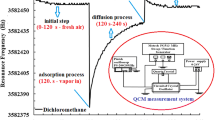Abstract
An optochemical ozone sensor is described that has been manufactured by immobilisation of novel soluble indigo derivatives in permeable transparent polymeric films of polydimethylsiloxane–polycarbonate copolymer. From a number of investigated indigo derivatives, 4,4′,7,7′-tetraalkoxyindigo 9 has been selected for optimal sensitivity and specificity of ozone detection. A linear calibration for ozone can be obtained in the range between 0.01 and 0.5 ppm. The limit of quantitation is 0.03 ppm, and the accuracy exceeds 8%. It takes about 134 s to measure the relatively low occupational exposure concentration of 0.1 ppm. A reduction of the sensor response time could be achieved through application of double-sided coated sensors instead of single-sided variants. The stability of the sensors and the effect of external parameters like relative humidity (RH), temperature and gas flow on the sensor response have been investigated. The sensor response is affected by varying the gas flow or temperature; however, humidity in the range between 0 and 90% RH does not affect sensor response. The indigo derivative 9 remained stable inside the polymeric film and no chemical reaction, crystallisation or leaching occurred during 10 months of observation. Proper choice of indicator dye and polymeric material and successful application of kinetic evaluation method for the exposure experiments determine the desired features of the sensor.



















Similar content being viewed by others
References
Parish DD, Fehsenfeld FC (2000) Atmos Environ 34:1921–1957
Manning WJ, Krupa SV, Bergweiler CJ, Nelson KI (1996) Environ Pollut 3:399–403
Geyh AS, Wolfson JM, Koutrakis P, Mulik JD, Avol EL (1997) Environ Sci Technol 31:2326–2330
Koutrakis P, Wolfson JM, Bunyaviroch A, Froehlich SE, Hirano K, Mulik JD (1993) Anal Chem 65:209–214
Bernard NL, Gerber MJ, Astre CM, Sainot MJ (1999) Environ Sci Technol 33:217–222
Scheeren BA, Adema EH (1996) Water Air Soil Pollut 91:335–350
Bader H, Hogine J (1981) J Water Res 15:449–456
Takeuchi K, Ibisuki T (1989) Anal Chem 61:619–623
Takeuchi K, Kutsuna S, Ibusuki T (1990) Anal Chim Acta 230:183–187
Collard RS, Pryor WA (1979) Anal Chim Acta 108:255–260
Schurath U, Speuser W, Schmidt R (1991) Fresenius J Anal Chem 340:544–547
Sauter D, Weimar U, Noetzel G, Mitrovics J, Göpel W (2000) Sens Actuators B 69:1–9
Kim SR, Hong HK, Kwon CH, Yun DH, Lee K, Sung YK (2000) Sens Actuators B 66:59–62
Qu W, Wlodarski W (2000) Sens Actuators B 64:42–48
Cantalini C, Wlodarski W, Li Y, Passacantando M, Cantucci S, Comini E, Faglia G, Sberveglieri G (2000) Sens Actuators B 64:182–188
Schütze A, Pieper N, Zacheja J (1995) Sens Actuators B 23:215–217
Bouvert M, Guillaud G, Leroy A, Maillard A, Spirkovitch S, Tournilhac FG (2001) Sens Actuators B 73:63–70
Bouvert M, Leroy A, Simon J, Tournilhac F, Guillaud G, Lessnick P, Maillard A, Spirkovitch S, Debliquy M, DeHaan A, Decroly A (2001) Sens Actuators B 72:86–93
Voss G, Gradzielski M, Heinze J, Reinke H, Unverzagt C (2003) Helv Chim Acta 86:1982–2004
Pèrez-Bendito D, Silva M (1988) Kinetical methods in analytical chemistry. Wiley, New York
Baron MG, Narayanaswamy R, Thrope SC (1995) Sens Actuators B 29:358–362
Ralfs M, Heinze J (1997) Sens Actuators B 44:257–261
Criegee R (1953) Justus Liebigs Ann Chem 583:1–36
Holt SJ, Sadler PW (1958) Proc R Soc Lond Ser B 148B:495–499
Holleman AF, Wiberg N (1995) Lehrbuch der anorganischen Chemie. de Gruyter, Berlin
Lüttke W, Klessinger M (1964) Chem Ber 97:2342–2357
Kromidas S (1999) Validierung in der Analytik. Wiley-VCH, Weinheim
Acknowledgements
Financial support by the German Research Foundation (DFG) and the Fonds der Chemischen Industrie is gratefully acknowledged.
Author information
Authors and Affiliations
Corresponding author
Rights and permissions
About this article
Cite this article
Alexy, M., Voss, G. & Heinze, J. Optochemical sensor for determining ozone based on novel soluble indigo dyes immobilised in a highly permeable polymeric film. Anal Bioanal Chem 382, 1628–1641 (2005). https://doi.org/10.1007/s00216-005-3291-4
Received:
Revised:
Accepted:
Published:
Issue Date:
DOI: https://doi.org/10.1007/s00216-005-3291-4




